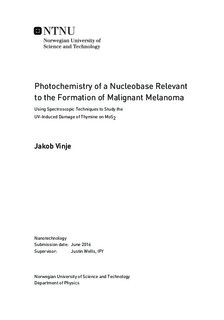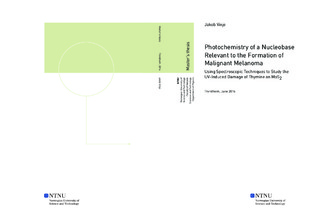| dc.description.abstract | Paring of nucleobases in deoxyribonucleic acid and the subsequent transcription of genes is arguably two of the most important processes for life. When subject to ultra violet (UV) light, one of the nucleobases, thymine, can dimerise with a neighbouring thymine forming cyclobutane pyrimidine. This reaction is known for its ability to affect the replication of healthy epithelial cells and causing cancer of type malignant melanoma.
In this project the dimerisation between two pure thymine molecules was studied using X-ray Photoelectron Spectroscopy (XPS) and X-ray Absorption Spectroscopy (XAS). The experimental results have been interpreted by means of ab-initio calculations using second order Möller-Plesset perturbation theory.
Empirical data suggests that thymine undergoes severe changes upon ex- posure to high intensity UV light. The molecular modifications are primarily attributed to chemical changes in the functional groups around the pyrimidine, rather than breaking of the ring structure in the molecule.
The two oxygen and the two nitrogen atoms in thymine was found to evolve from being fairly equivalently bound in the molecule to show large bonding differences. A fact that is seen in the core level spectra from oxygen and nitrogen respectively. The photoemission spectra of the peaks both show significant asymmetries after exposure, in contrast to the situation before exposure.
A suggested explanation for the observed change in the experimental data is the tautomerisation of thymine. UV light is known to perturb the keto- enol equilibrium of some molecules, an equilibrium which defines the relative proportions of the different molecular tautomers. The agreement between experimental data and calculations indicate that UV light shifts this equilibrium for thymine as well. | |

